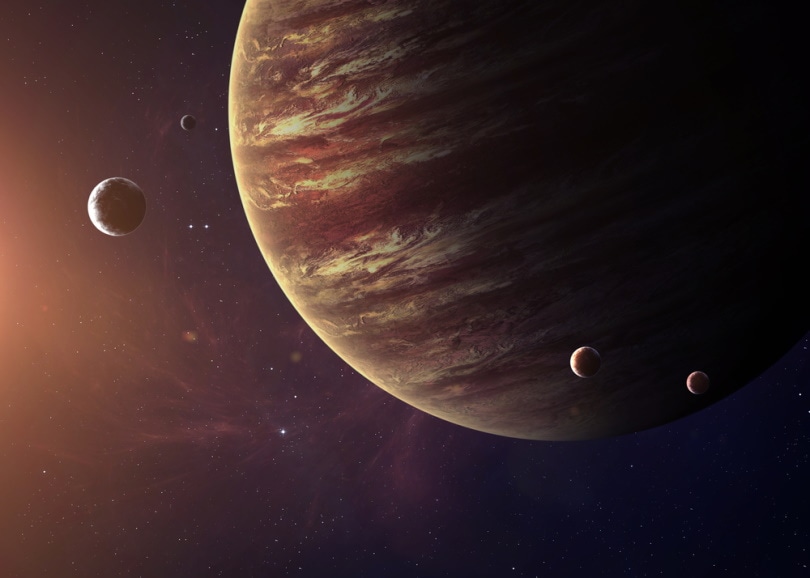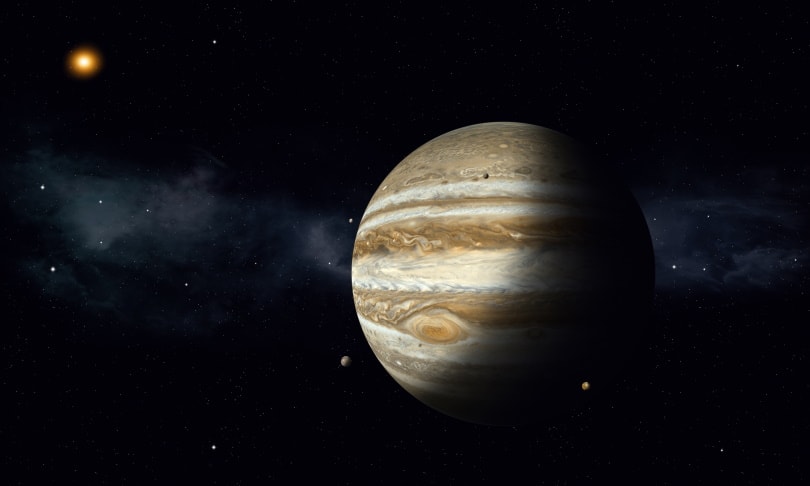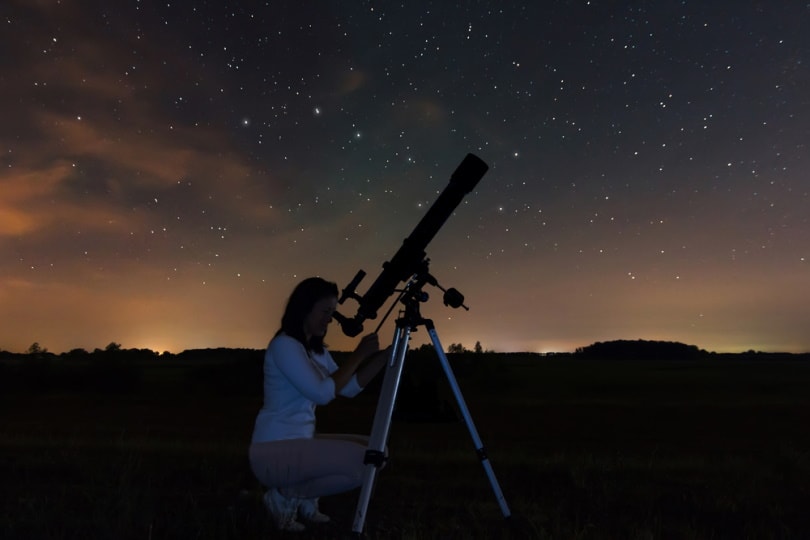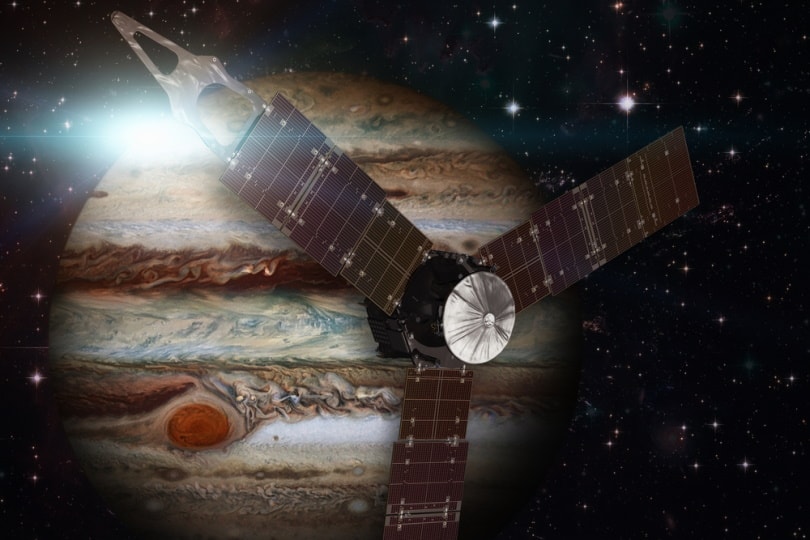How Many Moons Does Jupiter Have? The Surprising Answer!
Last Updated on

Jupiter is the largest planet in our solar system, and the fifth planet from the sun. According to Nasa, scientists now believe that Jupiter has 79 moons in total, of which 53 are named.
Jupiter’s four largest moons, Io, Europa, Ganymede, and Callisto were first discovered by Galileo Galilei, using his homemade refractor telescope in 1610. The four moons are also known as the Galilean satellites.
In this article, we’ll tell you more about the Galilean satellites, give you a full list of all of Jupiter’s named moons, and tell you how you can see some of Jupiter’s moons in the night sky.

What Are the Galilean Satellites?
Although many of Jupiter’s moons are interesting to learn about, the Galilean satellites are of significant scientific interest, boasting features such as deep oceans beneath icy surfaces, volcanic activity, and more.
Jupiter I: Io
Of the Galilean satellites, Io is the closest in orbit to Jupiter.
Jupiter’s third largest moon is also the fourth largest in the entire solar system. It boasts the highest density, and the strongest surface gravity of any moon in our solar system.
Io’s interior is constantly being pulled between Jupiter and its other moons. The friction that occurs during this tidal tug-of-war generates an incredible amount of heat energy, which is then released as volcanic activity. In fact, with over 400 active volcanoes, Io is the most volcanically active object in our solar system.

Jupiter II: Europa
Europa is the smallest of the four Galilean satellites, and yet one of the most interesting planets in our solar system.
The Jovian moon, which is slightly smaller than our moon, is covered in a thick shell of water ice, but scientists believe that around 15 miles beneath this ice is a hidden ocean of salty water that has the potential to harbour extraterrestrial microbial life.
Although Europa is smaller than Earth, the depth of its ocean, approximately 40 to 100 miles, means that it could contain double the water of all the oceans on Earth combined.
Jupiter III: Ganymede
Ganymede is the largest moon in our solar system. In fact, it is the ninth largest object in our solar system, larger than the planet Mercury.
Scientists have found evidence, through the Hubble Space telescope, of a subterranean saltwater ocean on Ganymede, making it possible that there may be primitive life there.
But an underground saltwater ocean is not the only fascinating feature when it comes to Ganymede. The third of the Galilean satellites is the only moon that creates its own magnetic field, which causes ribbons of aurorae to glow near its north and south poles.
Jupiter IV: Callisto
Callisto is Jupiter’s second largest moon, with a diameter that almost matches Mercury’s. Of the four Galilean satellites, it is the farthest from Jupiter, and the most cratered object in our solar system.
Scientists have speculated that there may be an ocean approximately 155 miles or deeper beneath Callisto’s surface. Its surface is believed to be more than 4 billion years old. Unlike Io, there is no evidence of volcanic or tectonic activity on Callisto.

How can you see Jupiter’s moons?
Jupiter itself can be seen with the naked eye, and usually appears as a soft yellow spot against the night sky.
To be able to spot Io, Europa, Ganymede, and Callisto as Galileo did back in 1610, all you need is a small 60 mm refractor telescope, or a pair of binoculars with 7x magnification. You’ll need very steady hands if you’re using binoculars, or better yet, a tripod.
Once you have the correct equipment, you’ll need a way to chart the night sky and know where to look on the night that you’ll go moon hunting.
Before the advent of smartphones and stargazing apps, people used physical almanacks and star guides to figure out where the planets were going to appear on any given date.
While these books and magazines are still a great resource, the quickest and easiest way to find Jupiter is to use a smartphone sky charting app. A sky charting app will usually tell you everything you need to know in real-time, based on your location.
When you do look at Jupiter through your telescope or binoculars, you should be able to spot 1-4 of the moons appearing in a straight line across the planet. A fun activity would be to repeat this for several nights in a row, charting the orbit of the moons just as Galileo did!

What are the names of Jupiter’s moons?
We’ve created a list naming 56 of Jupiter’s known moons in ascending order according to their orbital period. The first entry, Metis, is the closest moon to Jupiter.
| 1 | Metis | 13 | Himalia | 24 | Helike | 35 | Kale | 46 | Pasithee |
| 2 | Adrastea | 14 | Pandia | 25 | Orthosie | 36 | Taygete | 47 | Kore |
| 3 | Amalthea | 15 | Lysithea | 26 | Iocaste | 37 | Chaldene | 48 | Cyllene |
| 4 | Thebe | 16 | Elara | 27 | Praxidike | 38 | Eirene | 49 | Eukelade |
| 5 | Io | 17 | Dia | 28 | Harpalyke | 39 | Erinome | 50 | Pasiphae |
| 6 | Europe | 18 | Carpo | 29 | Mneme | 40 | Aoede | 51 | Hegemone |
| 7 | Ganymede | 19 | Valetudo | 30 | Hermippe | 41 | Kallichore | 52 | Arche |
| 8 | Callisto | 20 | Euporie | 31 | Thyone | 42 | Kalyke | 53 | Isonoe |
| 9 | Themisto | 21 | Eupheme | 32 | Ananke | 43 | Carme | 54 | Sinope |
| 10 | Leda | 22 | Thelxinoe | 33 | Herse | 44 | Callirrhoe | 55 | Sponde |
| 12 | Ersa | 23 | Euanthe | 34 | Aitne | 45 | Eurydome | 56 | Autonoe |


Conclusion
Jupiter has the largest number of moons out of all the planets in our solar system, because the size of the gas giant, and its relative distance from the sun mean that it has a gigantic gravitational pull. This gravitational pull has captured many objects over time, and these objects have fallen into its orbit, becoming moons.
In 2018, astronomers identified 12 new Jovian moons, bringing the total number of Jovian moons discovered so far to 79.
Jupiter’s four largest moons, also known as the Galilean satellites, are Io, Europa, Ganymede, and Callisto.
Featured Image Credit: Vadim Sadovski, Shutterstock
About the Author Cheryl Regan
Cheryl is a freelance content and copywriter from the United Kingdom. Her interests include hiking and amateur astronomy but focuses her writing on gardening and photography. If she isn't writing she can be found curled up with a coffee and her pet cat.
Related Articles:
Can You Use Binoculars to Look At Stars? How to Choose the Right Pair
15 Crucial Facts About Ultraviolet Rays & the Sun
What Constellation Is Spica In? The Interesting Answer!
10 Interesting Leo Constellation Facts, Myths, and FAQs
15 Interesting Pegasus Constellation Facts, Myths, and FAQs
6 Interesting Sagittarius Constellation Facts, Myths, and FAQs in 2024!
What Are Constellations? Where Did They Come From?
8 Interesting Libra Constellation Facts, Myths, and FAQs
